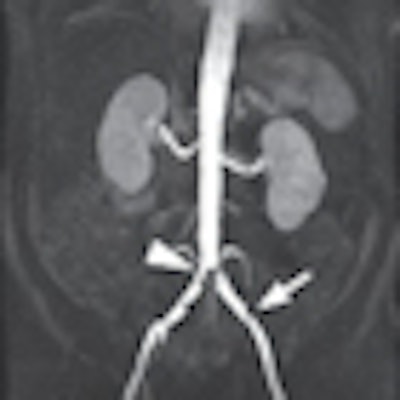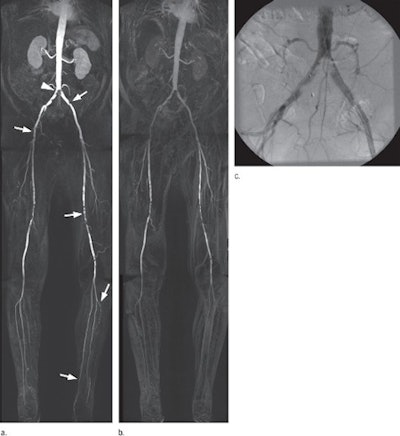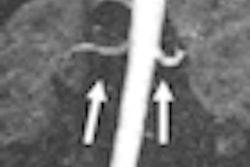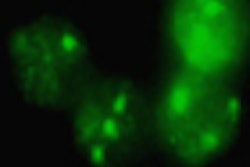
Gadobenate dimeglumine offers better performance than gadopentetate dimeglumine in patients undergoing contrast-enhanced MR angiography (MRA) for suspected peripheral arterial occlusive disease, according to a study in the June issue of Radiology.
Lead author Dr. Suzanne Gerretsen, from the department of cardiovascular MR research at Maastricht University Hospital in the Netherlands, and colleagues reached that conclusion after comparing patients who received 0.1 mmol/kg doses of each contrast agent.
The phase III multicenter study was sponsored by Bracco of Milan, Italy, manufacturer of gadobenate dimeglumine, which the company markets under the trade name MultiHance. Gadopentetate dimeglumine is sold by Bayer HealthCare Pharmaceuticals of Berlin under the trade name Magnevist (Radiology, Vol. 255:3, pp. 988-1000).
Signal-to-noise ratio versus NSF
The authors noted that while contrast-enhanced MR angiography is an accepted noninvasive alternative to digital subtraction angiography (DSA) to assess peripheral arterial occlusive disease, image quality may be inadequate if the contrast agent dose is too low.
Increasing contrast dose can improve signal-to-noise ratio, but greater levels of gadolinium also may increase the risk of nephrogenic systemic fibrosis (NSF), particularly in patients with renal insufficiency or end-stage renal disease.
The researchers reviewed data for 96 adult patients with suspected moderate to severe peripheral arterial occlusive disease at seven sites in Europe between November 2006 and January 2008. The study excluded patients with moderate to severe renal impairment, congestive heart failure, or a known allergy to either agent.
There were 62 men with a mean age of 64.3 years, ranging from 39 to 86 years of age, and 34 women with a mean age of 61.2 years, ranging from 40 to 81 years of age.
Eligible patients were randomized prospectively to two groups, with one group of 52 patients receiving gadobenate dimeglumine for their first examination and gadopentetate dimeglumine for the second scan. The second group of 44 patients received the contrast agents in reverse order.
All procedures were performed on 1.5-tesla MRI systems (Magnetom Avanto from Siemens Healthcare of Erlangen, Germany; Intera, Achieva, and Gyroscan Intera from Philips Healthcare of Andover, MA). Peripheral arterial vasculature imaging was performed from the aortic bifurcation to the lower leg in three stations, which included the pelvis, thigh, and calf, and excluded the foot.
Dose administration
Overall, 92 of the 96 patients received doses of both gadobenate dimeglumine and gadopentetate dimeglumine, administered at 0.1 mmol/kg. There were four patients (two from each group) who discontinued participating in the study after the first examination.
The time between examinations for each patient ranged from three to 13 days, with 86 of the 96 patients imaged between four and seven days.
There were 31 patients among the 96 subjects who underwent both contrast-enhanced MR angiography and conventional DSA (17 patients in the first group and 14 patients in the second group). DSA was performed from one to 110 days before the first contrast-enhanced MR angiogram or from one to 221 days after the second contrast-enhanced MR angiogram.
All 96 patients were monitored for adverse reactions to the contrast agents for 24 hours after administration of the first contrast agent, and then again from 24 hours before until 24 hours after receiving the second dose of contrast agent.
The researchers assessed a total of 564 stations, with an equal number of 188 in the pelvis, thigh, and calf among 94 patients who received at least one contrast agent. They found that "significantly fewer stations were technically inadequate after gadobenate dimeglumine than after gadopentetate dimeglumine." There were 20 (4%) technically inadequate stations using gadobenate dimeglumine, compared with 67 (12%) with gadopentetate dimeglumine.
Superior quality
Superior vessel visualization quality was found with gadobenate dimeglumine when imaging the pelvis, thigh, and calf. In addition, 491 (87%) of 564 stations were classified as "good" or "excellent" image quality when using gadobenate dimeglumine, compared with 413 (73%) of 562 stations with gadopentetate dimeglumine.
The researchers also found that poor images occurred for calf vessels in 10% (18) of the cases with gadobenate dimeglumine, compared with 20% (38) of calf vessels with gadopentetate dimeglumine. Poor images also occurred for the pelvis in 2% (3) of the cases with gadobenate dimeglumine, compared with 7% (13) of the cases with gadopentetate dimeglumine. With thigh images, poor images resulted for 2% (3) of the vessels with gadobenate dimeglumine, compared with 14% (26) for gadopentetate dimeglumine.
In total, 24 (4%) stations were deemed of poor quality when using gadobenate dimeglumine, compared with 77 (14%) of stations when using gadopentetate dimeglumine.
 |
|
MR images are of a 72-year-old man showing moderate claudication in right and left thigh and calf after a dose of 0.1 mmol/kg of gadobenate dimeglumine (a) and gadopentetate dimeglumine (b). Gadobenate dimeglumine results in better visualization of peripheral arterial vasculature and better depiction of vascular disease. There is better delineation of plaque formation in aortic bifurcation (arrowhead, a) extending to both iliac arteries, and clearer depiction of extent of stenosis (arrow) in left common iliac artery is achieved, relative to corresponding DSA image (c). Better enhancement of thigh station with gadobenate dimeglumine allows exclusion of significant stenosis (arrow) in right common femoral artery, while multiple stenoses (arrows) in left superficial femoral artery are better seen. Images courtesy of Radiology.
|
DSA results
There were a total of 397 vascular segments evaluated among the 31 DSA patients. DSA was able to show clinically relevant disease in 127 (32%) of 397 segments, with each reader reporting "significantly better diagnostic performance" with gadobenate dimeglumine than with gadopentetate dimeglumine.
The readers' analysis calculated an increase in sensitivity of 11% to 18%, a gain in specificity of 4% to 9%, and better accuracy by 8%. Each reader also reported significantly higher predictive values with gadobenate dimeglumine, with differences ranging from 13% to 19% for positive predictive value and from 6% to 8% for negative predictive value.
Regarding stenosis detection, good to excellent reader agreement was achieved, with all three readers agreeing on 591 (90%) of 655 segments assessed on gadobenate dimeglumine-enhanced images, compared with 529 (88%) of 604 segments on gadopentetate dimeglumine-enhanced images.
Safety first
Six adverse events were reported by four patients after gadobenate dimeglumine, compared with eight adverse events experienced by five patients after gadopentetate dimeglumine. All adverse events were not considered serious and ranged from dizziness and nausea to vomiting, chest pain, and heat sensation.
The study demonstrates that "image quality and diagnostic accuracy for the detection of clinically relevant peripheral arterial occlusive disease are significantly improved at peripheral contrast-enhanced MR angiography with a dose of 0.1 mmol/kg of gadobenate dimeglumine compared with a dose of 0.1 mmol/kg of gadopentetate dimeglumine," the researchers concluded.
By Wayne Forrest
AuntMinnie.com staff writer
May 24, 2010
Related Reading
MGH study: Adverse reactions to gadolinium contrast are rare, January 22, 2010
Italian researchers cut gadolinium dose -- as well as NSF risk, January 21, 2010
FDA panel: NSF incidence falls with gadolinium restrictions, December 9, 2009
MRI contrast media switch eliminates NSF cases, October 15, 2009
Mayo study finds few serious reactions to CT and MRI contrast, September 21, 2009
Copyright © 2010 AuntMinnie.com



















